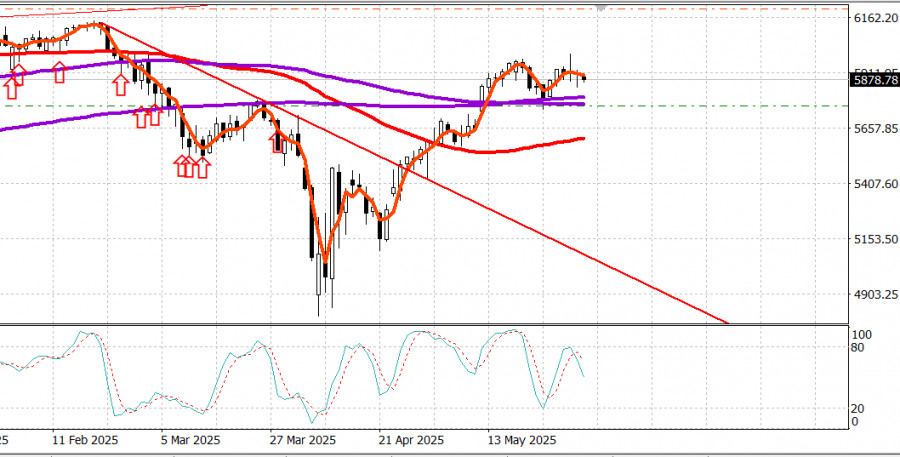S&P500
Snapshot of major US stock indices on Friday: Dow +0.1%, NASDAQ -0.3%, S&P 500 flat (0%), closing at 5911, within the 5400–6200 range.
Catalysts of the trading session on Monday
On Friday evening, former President Donald Trump announced he would raise tariffs on all steel and aluminum to 50%, declaring a new wave in his tariff wars. As a result, US markets are slightly down in pre-market electronic trading Monday morning.
Recap of the trading session on Friday
The last trading day of May — a strong month for the market overall — ended with mixed signals. The morning session reflected a defensive mood and a dose of trade anxiety, triggered by Trump's social media post accusing China of violating a preliminary trade agreement with the US. He added sarcastically, "That's all it takes to be Mr. NICE GUY!"
This sent major indices lower, even though the April Personal Income and Spending Report offered some encouraging signs, including moderating inflation and steady growth in real disposable personal income.
The indices hit session lows shortly after lunchtime in New York, following a Bloomberg report that the US might impose additional tech-related sanctions on China.
The S&P 500 dropped to 5,843, down 1.2% intraday, but fully rebounded back into positive territory by the afternoon. This recovery was driven by buy-the-dip activity, a strategy that has worked repeatedly since the April 7 lows, further supported by Trump's statement at an Oval Office press conference, where he said he would likely speak with President Xi and hoped to resolve all issues.
That statement helped ease trade-related tensions heading into the weekend and likely triggered short covering activity, contributing to the market's recovery.
Key stocks & sector performance:
Large-cap growth stocks were not particularly strong but did play a role in the afternoon rebound. The Vanguard Mega-Cap Growth ETF (MGK), which was down 1.5% at the S&P's intraday low, ended the session with only a 0.2% decline.
There wasn't broad strength in the market on Friday, but select individual stocks stood out:
Ulta Beauty (ULTA) jumped to $471.46, up +$49.67 (+11.8%) after strong earnings. Costco (COST) rose to $1,040.18, up +$31.44 (+3.1%), also on earnings. Costco's rally helped lift the consumer staples sector (+1.2%) to the top of the sector performance leaderboard, alongside utilities (+1.1%).
The only sectors that posted losses were energy (-0.7%), consumer discretionary (-0.6%), and information technology (-0.4%).
NVIDIA (NVDA 135.13, -4.06, -2.9%) and semiconductor stocks came under notable selling pressure. The Philadelphia semiconductor index dropped 2.1%, though to be fair, it had risen 14.6% month-to-date going into Friday's session, far outpacing the S&P 500's +6.2%, which marked its best month since 2023.
Treasury securities were relatively stable, with a slight positive bias — short-term yields outperformed long-term ones. End-of-month pension fund rebalancing (from equities into bonds) was seen as a source of support.
Year-to-date performance:
- S&P 500: +0.5%
- DJIA: -0.6%
- Nasdaq: -1.0%
- S&P 400 MidCap: -3.8%
- Russell 2000: -7.3%
Economic calendar on Friday:
Personal Income rose 0.8% MoM in April (consensus: 0.3%) after an upwardly revised 0.7% in March (from 0.5%).
Personal Spending increased 0.2% MoM, in line with expectations, following an unrevised 0.7% rise in March.
The PCE Price Index rose 0.1% MoM, as expected, bringing the YoY rate down to 2.1% from 2.3% in March.
The Core PCE Price Index also rose 0.1% MoM, as expected, lowering the YoY rate to 2.5% from 2.7%.
Key takeaways from the report:
Inflation is easing. Income growth remains strong.
The personal savings rate increased to 4.9% from 4.3% in March, indicating pent-up spending potential that may keep the economy on a growth path through Q2.
Other macroeconomic data:
The final University of Michigan Consumer Sentiment Index for May rose to 52.2 (consensus: 50.8), unchanged from April's final reading. A year ago, the index stood at 69.1.
The key takeaway: this ends four straight months of sharp declines in sentiment, although consumers remain concerned about personal finances and the economic outlook, with inflation expectations still weighing on confidence.
Chicago PMI (May) fell to 40.5 (consensus: 45.0) from 44.6 in April.
The goods trade deficit narrowed to $87.6B from -$162.3B.
Retail inventories fell 0.1% after a 0.3% drop in March.
Wholesale inventories were flat following a 0.3% increase in March.
Energy sector
Brent crude is now trading at $64.20. The market is under pressure due to OPEC sentiment favoring increased oil production.
Conclusion
The US stock market is consolidating below recent highs. A new wave of tariff tensions initiated by Trump could trigger a fresh correction. However, for now, we maintain a buy-the-dip strategy, which means buying on rebounds.













